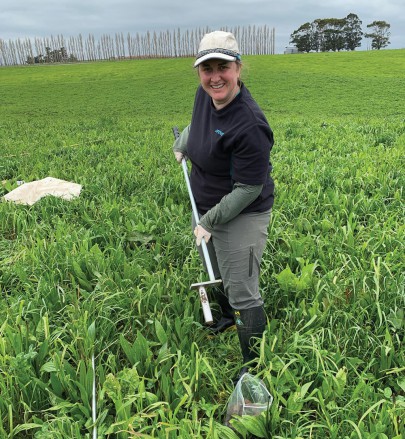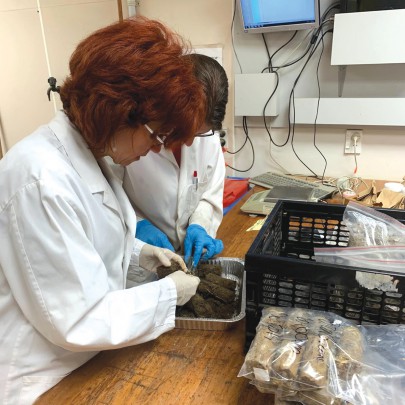
Dr Kara Allen collecting topsoil samples
Googling ‘regenerative agriculture’ reveals a colossal amount of information, including many claims about its environmental, economic, and social benefits. Yet, despite abundant anecdotal evidence, little academic research has been undertaken to show whether or how regen ag delivers these benefits, particularly in a New Zealand context.
To address this knowledge gap, Gwen Grelet, a soil ecologist from Manaaki Whenua, is leading a pilot project funded through MBIE’s Strategic Science Investment Fund and MPI, baselining ecosystem performance of conventionally managed and regeneratively run farms in New Zealand, across roughly 20 indicators.
The project includes both dairy and drystock pastoral farms in the south of New Zealand. Here, flooding and cold temperatures create substantial challenges, especially for winter feeding, which is one of the motivations for transitioning to regenerative management.
The indicators include visual soil assessments, soil moisture and water infiltration, aggregate stability (how well the soil holds together), soil carbon and nitrogen stocks to a depth of 1 metre, and various indicators of ecosystem biodiversity, including plants, insects, soil invertebrates and soil microbes. Some farms have also agreed to participate in an assessment of economic metrics (profitability and business resilience).
‘Regenerative agriculture emphasises management strategies that are constantly adapting and are context-specific, not “one-size-fits-all”,’ says Gwen. ‘Regenerative agriculture also aims to optimise the performance of the whole farm for multiple benefits simultaneously, so its impacts aren’t easy to quantify using conventional methods.’
The pilot is a collaboration, including Kate Orwin, Paul Mudge and Nina Koele, plus several other Manaaki Whenua scientists, as well as external collaborators such as Quorum Sense, BakerAg, 5thbusinessAgri, Plant & Food Research, and AgResearch.

Dr Gwen Grelet and Ngaire Foster analyse soil cores in the lab
Gwen is also leading or co-leading two other projects on regenerative agriculture. The first is a trans-Tasman project funded by the Australian Soil Cooperative Research Centres Program. This project takes a co-innovation approach, including researchers, farmers, agency representatives and extension practitioners, to understand the role of soil carbon in regenerative farming systems and how it might improve the performance of Australian soils across various soil types and climates.
The second, funded by Our Land and Water National Science Challenge and the NEXT Foundation, in partnership with MPI, is a survey of New Zealand farmers, industry, government and scientists. It will uncover any questions they have about regenerative agriculture, identify the main principles and objectives of regenerative farming systems in New Zealand (dairy, drystock, arable and viticulture/horticulture), and show how these differ from similar systems overseas.
The survey work will also develop a framework for building a scientific evidence base specific to regenerative agriculture in New Zealand across all priority environmental, economic and social outcomes, so that future research can quickly fill the evidence gaps.
The work is particularly timely given global and national uncertainties over the economic effects of COVID-19 and the need to enhance New Zealand’s agricultural resilience in global marketplaces increasingly dominated by environmentally and ethically minded consumers.

